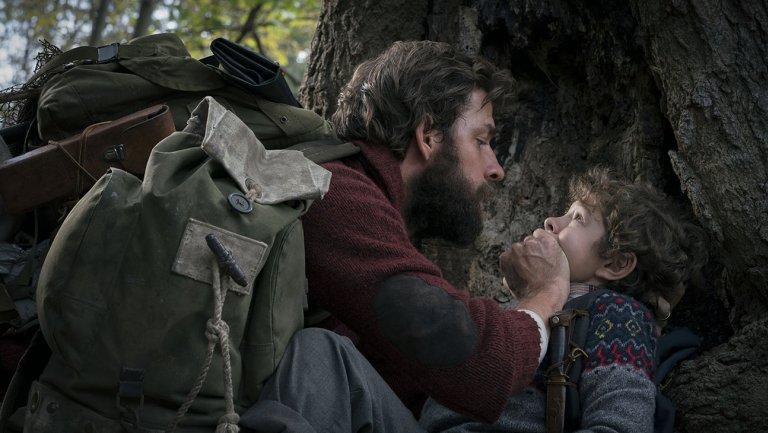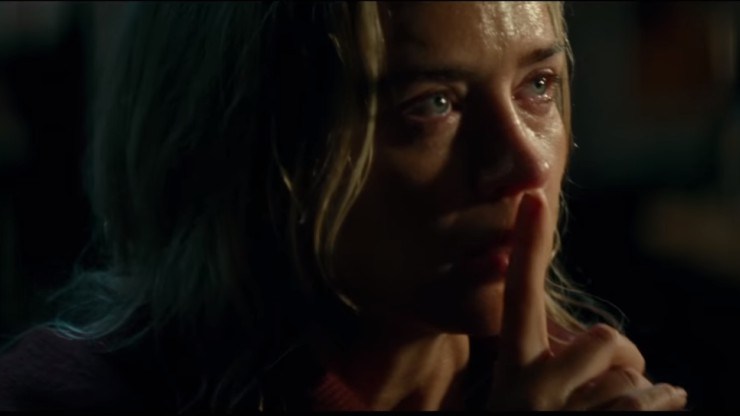A Quiet Place (2018)
CAST: Emily Blunt, John Krasinski, Millicent Simmonds, Noah Jupe
REVIEW:
A Quiet Place, from writer/director/co-star John Krasinski (whose screenplay is a rewrite of a script by Bryan Woods and Scott Beck), is an experimental venture into understated terror that does most things adequately, a few things exceptionally, but ultimately doesn’t have enough distinguishing itself to ascend to horror classic. The result is an interestingly offbeat diversion, but ultimately feels a little insubstantial and shallowly-developed when all is said and done.
We open with the subtitle “Day 89”, a few months after vicious alien (?) creatures have overran humanity and only a few survivors are seemingly left. We don’t know much about what the creatures are or where they came from, but they’re blind, seemingly invulnerable, and have super-sensitive hearing. Those who have survived have done so by embracing almost total silence. We’re introduced the five-member Abbott family, mother Evelyn (Emily Blunt), father Lee (John Krasinski), deaf teenage daughter Regan (Millicent Simmonds), younger son Marcus (Noah Jupe), and the youngest Beau (Cade Woodward), who is too young to fully understand the dangers of this new world he’s growing up in. The family creeps barefoot and stealthy around an abandoned drug store to find medicine for an ailing Marcus, but on the way back tragedy strikes when Beau turns on a toy rocket he’s smuggled out with him. From there, we jump ahead a year. The Abbott clan is down to four, but soon to be back to five when heavily pregnant Evelyn gives birth. Lee has not been idle, making an attempt to improve the home defenses with a colored-light warning system, security monitors, and a soundproof underground room. Of course, if everything went smoothly, there wouldn’t be much of a movie, and you don’t have to be a horror movie connoisseur to guess that circumstances will conspire to imperil Evelyn at the worst possible time.
 A Quiet Place leaves much vague and ambiguous. Apart from some scattered newspaper headlines that serve as basic exposition—the creatures are blind and hunt by sound, and civilization has collapsed—Krasinski isn’t interested in backstory. At night, when Lee sets a fire atop the silo like a signal beacon, we see others lighting up in the distance, indicating the Abbotts are not the only family in the region that’s survived, but we don’t meet anyone else. The focus stays tightly and firmly on the Abbotts, and apart from a couple one-scene bit parts—who are swiftly dispatched—this is a four-person show. Krasinski adds some interesting touches, taking the time to show us the details of the tricks of survival the Abbotts have come up with, including marking where to step in the house with splotches of paint to avoid creaking floors, making paths of sand through the forest and town to make their periodic journeys for supplies as quiet and inconspicuous as possible, the colored-light warning system, and Lee’s tinkering with a hearing aid for Regan that eventually pays off as a deus ex machina. Krasinski effectively conveys how oppressive and claustrophobic silence can be, taken even further in scenes from Regan’s perspective, where all sound is blotted out so the audience hears what she hears, which is virtually nothing (of course, this lends itself to a creepy moment or two when Regan is oblivious to what might be around her). Actress Millicent Simmonds is deaf in real-life, a casting prerequisite that Krasinski insisted on for a touch of authenticity. When sound happens, it’s often abrupt and jarring. Living such a carefully silent lifestyle, danger can come on swifts wings from the tiniest slip up—a child knocking over a lamp, a loose nail catching on Evelyn’s dress and dislodging a floorboard. The audience may find itself holding its breath at various points as much as the characters are doing. The Abbotts communicate primarily via subtitled sign language; spoken conversations are limited to two scenes, one where Lee and Marcus have a short talk under cover of a roaring waterfall, and another between Lee and Evelyn in the soundproof room. This makes the cast more reliant on expressions and body language than spoken dialogue.
A Quiet Place leaves much vague and ambiguous. Apart from some scattered newspaper headlines that serve as basic exposition—the creatures are blind and hunt by sound, and civilization has collapsed—Krasinski isn’t interested in backstory. At night, when Lee sets a fire atop the silo like a signal beacon, we see others lighting up in the distance, indicating the Abbotts are not the only family in the region that’s survived, but we don’t meet anyone else. The focus stays tightly and firmly on the Abbotts, and apart from a couple one-scene bit parts—who are swiftly dispatched—this is a four-person show. Krasinski adds some interesting touches, taking the time to show us the details of the tricks of survival the Abbotts have come up with, including marking where to step in the house with splotches of paint to avoid creaking floors, making paths of sand through the forest and town to make their periodic journeys for supplies as quiet and inconspicuous as possible, the colored-light warning system, and Lee’s tinkering with a hearing aid for Regan that eventually pays off as a deus ex machina. Krasinski effectively conveys how oppressive and claustrophobic silence can be, taken even further in scenes from Regan’s perspective, where all sound is blotted out so the audience hears what she hears, which is virtually nothing (of course, this lends itself to a creepy moment or two when Regan is oblivious to what might be around her). Actress Millicent Simmonds is deaf in real-life, a casting prerequisite that Krasinski insisted on for a touch of authenticity. When sound happens, it’s often abrupt and jarring. Living such a carefully silent lifestyle, danger can come on swifts wings from the tiniest slip up—a child knocking over a lamp, a loose nail catching on Evelyn’s dress and dislodging a floorboard. The audience may find itself holding its breath at various points as much as the characters are doing. The Abbotts communicate primarily via subtitled sign language; spoken conversations are limited to two scenes, one where Lee and Marcus have a short talk under cover of a roaring waterfall, and another between Lee and Evelyn in the soundproof room. This makes the cast more reliant on expressions and body language than spoken dialogue.
A Quiet Place is slow burn and at least for a while moves at a leisurely pace that might be derided by some of our increasingly ADD-riddled audiences as boring. Apart from the opening, which demonstrates abruptly that small children are not above being killed off, there’s not much “action”, and the creatures are limited to fleeting glimpses. Later on, there are several sequences where things ratchet up to pulse-pounding tension, most prominently a scene in which Evelyn hides in the bathtub, struggling to stay silent while simultaneously enduring labor pains and the terror of being stalked by a creature, another sequence with a character cornered in a flooding room, a chase through a cornfield, and a struggle to survive in a silo filled with grain that can suck a victim down as fast as quicksand. There’s also a couple effective low-key character interaction moments, including Lee and Marcus’ conversation by the waterfall, which has more impact because it’s the first time, well into the movie, that we hear anyone speak out loud, and a tender interlude where Lee and Evelyn share earbuds to slow dance to Neil Young’s “Harvest Moon”.
Alas, despite various intriguing elements, at least several intensely anxiety-inducing sequences, and credible, low-key performances from the real-life husband-and-wife duo of Emily Blunt and John Krasinski and their young co-stars Millicent Simmonds and Noah Jupe, a few factors hold A Quiet Place back. One is the lack of backstory or explanation (although some might view that as a positive). Another is an overreliance on jump scares, accompanied by sharp musical notes. Third is that, when the creatures appear in more-or-less full view, their designs are generic (bearing a resemblance to the Cloverfield monster) and the CGI is over-obvious. Their eventually revealed weakness also feels like a bit of a convenient deus ex machina. There’s also a few plot holes and typical horror movie examples of characters doing illogical things that feel less like natural behavior and more like the script orchestrating ways to get everybody into harm’s way (the most glaring example is the very fact, upon which much of the plot hinges, that Evelyn and Lee would become pregnant again, which seems terribly poorly ill-considered; how does one survive in silence with a baby?). Comparisons to Ridley Scott’s sci-fi horror classic Alien are, for my money, significantly overstating the matter. In fact, A Quiet Place‘s closest cinematic cousin that comes to mind is M. Night Shyamalan’s Signs.
Ultimately, A Quiet Place is capably-crafted for what it is, but what it is remains a little too insubstantial to earn it a rave recommendation. For a few scares at the theater, with a little creativity along the way, it’s a worthy enough diversion whose hour and thirty minute runtime doesn’t wear out its welcome, but it’s no challenger to classics of the genre like Alien.
* * *
